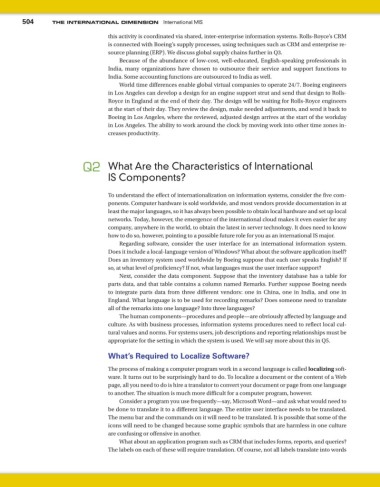Page 536 - Using MIS
P. 536
504 tHe InternatIonal DIMenSIon International MIS
this activity is coordinated via shared, inter-enterprise information systems. Rolls-Royce’s CRM
is connected with Boeing’s supply processes, using techniques such as CRM and enterprise re-
source planning (ERP). We discuss global supply chains further in Q3.
Because of the abundance of low-cost, well-educated, English-speaking professionals in
India, many organizations have chosen to outsource their service and support functions to
India. Some accounting functions are outsourced to India as well.
World time differences enable global virtual companies to operate 24/7. Boeing engineers
in Los Angeles can develop a design for an engine support strut and send that design to Rolls-
Royce in England at the end of their day. The design will be waiting for Rolls-Royce engineers
at the start of their day. They review the design, make needed adjustments, and send it back to
Boeing in Los Angeles, where the reviewed, adjusted design arrives at the start of the workday
in Los Angeles. The ability to work around the clock by moving work into other time zones in-
creases productivity.
Q2 What Are the Characteristics of International
IS Components?
To understand the effect of internationalization on information systems, consider the five com-
ponents. Computer hardware is sold worldwide, and most vendors provide documentation in at
least the major languages, so it has always been possible to obtain local hardware and set up local
networks. Today, however, the emergence of the international cloud makes it even easier for any
company, anywhere in the world, to obtain the latest in server technology. It does need to know
how to do so, however, pointing to a possible future role for you as an international IS major.
Regarding software, consider the user interface for an international information system.
Does it include a local-language version of Windows? What about the software application itself?
Does an inventory system used worldwide by Boeing suppose that each user speaks English? If
so, at what level of proficiency? If not, what languages must the user interface support?
Next, consider the data component. Suppose that the inventory database has a table for
parts data, and that table contains a column named Remarks. Further suppose Boeing needs
to integrate parts data from three different vendors: one in China, one in India, and one in
England. What language is to be used for recording remarks? Does someone need to translate
all of the remarks into one language? Into three languages?
The human components—procedures and people—are obviously affected by language and
culture. As with business processes, information systems procedures need to reflect local cul-
tural values and norms. For systems users, job descriptions and reporting relationships must be
appropriate for the setting in which the system is used. We will say more about this in Q5.
What’s Required to Localize Software?
The process of making a computer program work in a second language is called localizing soft-
ware. It turns out to be surprisingly hard to do. To localize a document or the content of a Web
page, all you need to do is hire a translator to convert your document or page from one language
to another. The situation is much more difficult for a computer program, however.
Consider a program you use frequently—say, Microsoft Word—and ask what would need to
be done to translate it to a different language. The entire user interface needs to be translated.
The menu bar and the commands on it will need to be translated. It is possible that some of the
icons will need to be changed because some graphic symbols that are harmless in one culture
are confusing or offensive in another.
What about an application program such as CRM that includes forms, reports, and queries?
The labels on each of these will require translation. Of course, not all labels translate into words

